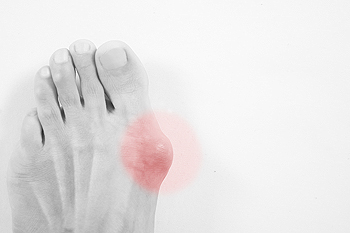
A bunion is easy to notice. It is a hard bump on the side of the big toe and will get larger if steps are not taken to reduce it. A bunion generally occurs from wearing shoes that have little room in the toe area, such as high heels. Frequently wearing these types of shoes may cause the other toes to shift together. Corns and calluses may form on top of the toes as they touch the shoe. Bunions can also happen from genetic reasons, or from existing arthritis. The symptoms that are commonly associated with bunions can include pain and stiffness in the big toe, and the gait, or walking style can be affected. Temporary relief may be found when shoes are purchased to accommodate the bunion. Some people find it can help to wear a protective pad on top of the bunion, in addition to taking over-the-counter pain medicine. If you have developed this type of foot condition, it is suggested that you contact a podiatrist who can offer you treatment options, which may include surgery for permanent relief.
If you are suffering from bunion pain, contact one of our podiatrists of Romeo Foot & Ankle Clinic. Our doctors can provide the care you need to keep you pain-free and on your feet.
What Is a Bunion?
Bunions are painful bony bumps that usually develop on the inside of the foot at the joint of the big toe. As the deformity increases over time, it may become painful to walk and wear shoes. Women are more likely to exacerbate existing bunions since they often wear tight, narrow shoes that shift their toes together. Bunion pain can be relieved by wearing wider shoes with enough room for the toes.
Causes
- Genetics – some people inherit feet that are more prone to bunion development
- Inflammatory Conditions - rheumatoid arthritis and polio may cause bunion development
Symptoms
- Redness and inflammation
- Pain and tenderness
- Callus or corns on the bump
- Restricted motion in the big toe
In order to diagnose your bunion, your podiatrist may ask about your medical history, symptoms, and general health. Your doctor might also order an x-ray to take a closer look at your feet. Nonsurgical treatment options include orthotics, padding, icing, changes in footwear, and medication. If nonsurgical treatments don’t alleviate your bunion pain, surgery may be necessary.
If you have any questions, please feel free to contact our offices located in Washington and Shelby Townships, MI . We offer the newest diagnostic and treatment technologies for all your foot care needs.
